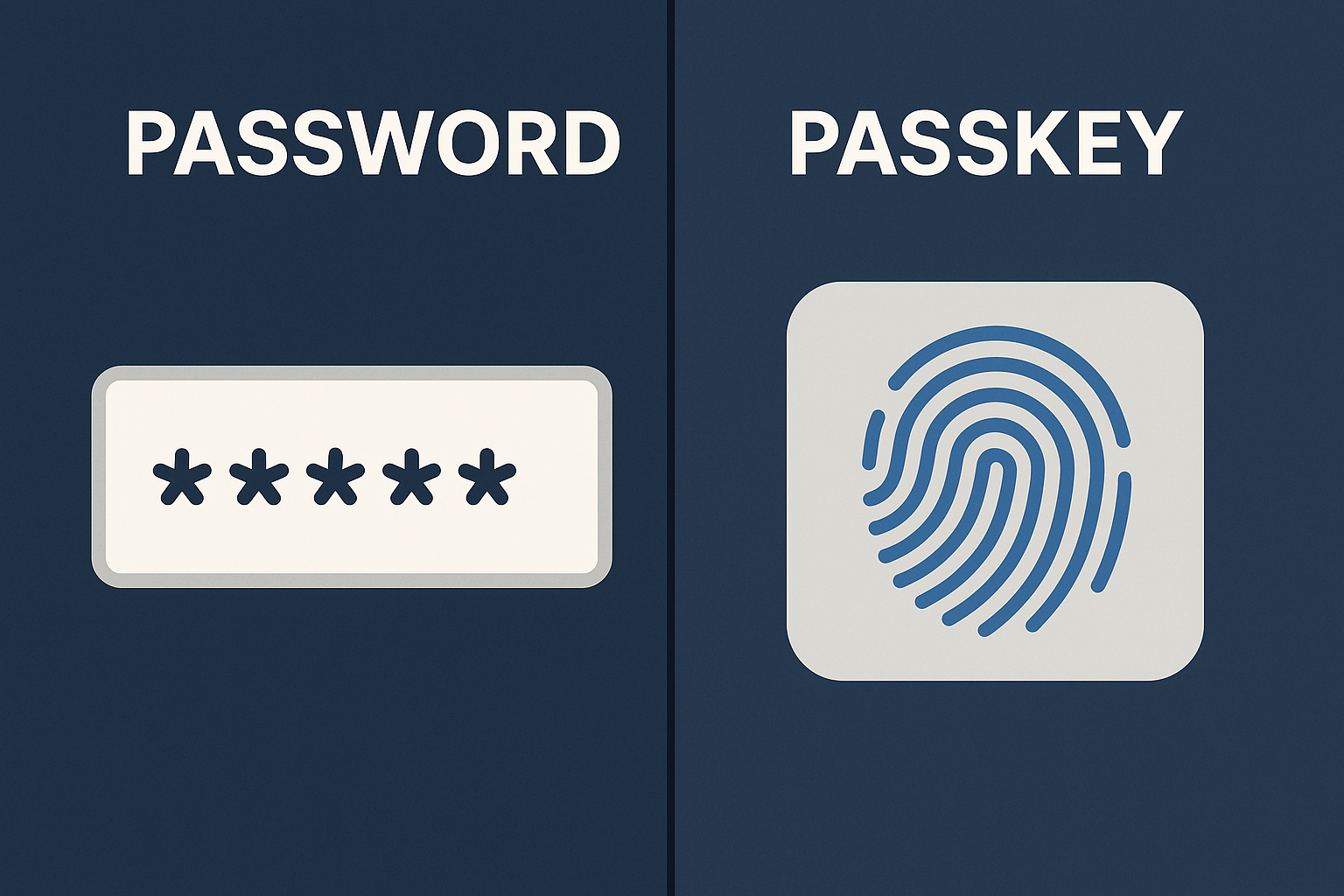Passkeys vs. Passwords: A Detailed Comparison
Explore the evolving landscape of digital security as we delve into the distinctions between passkeys and passwords. Understand their unique features, advantages, and potential drawbacks to determine the optimal choice for safeguarding your online presence.

Our lives are increasingly intertwined with the online world, robust online security is no longer a luxury but a necessity. With the rising tide of cyber threats, safeguarding our online accounts has become more critical than ever. For decades, passwords have been the steadfast guardians of our digital identities, but a new technology known as "passkeys" is emerging as a more secure and user-friendly alternative.
This article delves deep into the intricacies of passwords and passkeys, comparing their strengths and weaknesses, and exploring which websites and industries are best suited for each method.
Industry Adoption of Passkeys
The shift towards passkeys is not merely a theoretical concept; it's a tangible trend gaining momentum across diverse industries. Leading companies and organizations are recognizing the advantages of passkeys and actively integrating them into their platforms. Here are some notable examples:
- E-commerce: Giants like Amazon, Best Buy, eBay, and Shopify have embraced passkeys, aiming to enhance security and streamline the shopping experience for millions of users. Amazon, for instance, has over 175 million customers already using passkeys.
- Technology: Tech titans such as Google, Microsoft, Apple, and Sony Interactive Entertainment have integrated passkey support into their ecosystems, paving the way for widespread adoption. Google alone has recorded over 2.5 billion passkey sign-ins across 800 million Google accounts.
- Financial services: Security and trust are paramount in the financial sector. Consequently, companies like PayPal, Mastercard, Visa, and numerous digital banks are adopting passkeys to bolster security measures and combat fraud.
- Public sector: Government agencies are also joining the passkey movement. Australia's MyGov platform exemplifies this trend, utilizing passkeys to streamline citizen services and safeguard sensitive information.
- Social media: Popular social media platforms like X (formerly Twitter) and Discord have incorporated passkey support, recognizing the need for enhanced security and user-friendliness in online interactions.
These examples illustrate the growing recognition of passkeys as a viable and superior alternative to traditional passwords. The increasing adoption across various sectors underscores the potential of passkeys to reshape the landscape of online authentication.
How Passwords Work
To fully appreciate the advantages of passkeys, it's essential to understand the inner workings of traditional passwords and their inherent limitations. Passwords are essentially secret codes that users create to verify their identity when accessing online accounts. When you create a password, the website or application typically employs a process called "hashing" to store it securely in a database. Imagine a special machine that takes your password and jumbles it up into a unique, fixed-length string of characters. This "hashed" password is what's stored, making it incredibly difficult for hackers to decipher even if they manage to breach the database. When you log in, the system hashes the password you enter and compares it to the stored hash. If they match perfectly, like two puzzle pieces fitting together, you are granted access.
While hashing adds a layer of protection, passwords are not without their vulnerabilities. They are susceptible to various attacks, such as:
- Brute-force attacks: Think of a relentless robot trying every possible combination of characters until it stumbles upon your password. This is a brute-force attack, where hackers use automated tools to crack passwords.
- Dictionary attacks: Hackers employ another tactic called dictionary attacks, where they use lists of common passwords and their variations to guess your password. It's like trying to unlock your door by trying every key on a giant key ring.
- Phishing attacks: Phishing is a deceptive technique where hackers try to trick you into revealing your password. They might send you a fake email that looks like it's from your bank, asking you to "verify" your password.
- Credential stuffing: In this attack, hackers use stolen passwords from one website to try and access other accounts. It's like finding a key that unlocks multiple doors.
To mitigate these risks, users are constantly urged to create strong passwords that are long, complex, and unique to each account. However, remembering and managing a multitude of strong passwords can be a daunting task, often leading to poor password hygiene and increased vulnerability. In fact, insecure or missing passwords are responsible for over half of Google Cloud breaches.
Historically, passwords were stored as plain text in databases, making them easily accessible to anyone who gained unauthorized access. This vulnerability prompted the development of hashing and other security measures to protect passwords.
How Passkeys Work
Passkeys offer a new paradigm in online authentication, moving away from the vulnerabilities of traditional passwords. They are based on public-key cryptography, a system that uses a pair of keys – a public key and a private key – to secure information. Imagine having two keys: one that you can give to anyone and another that you keep hidden in a safe place. The public key is like the one you share, while the private key is the one you guard closely. When you create a passkey, your device generates this key pair. The public key is stored on the website or application's server, while the private key remains securely on your device, often protected by an additional layer of security like your fingerprint or facial recognition.
When you log in with a passkey, your device uses the private key to sign a challenge from the server. It's like using your hidden key to create a unique signature that only you can produce. This signature verifies your identity without ever transmitting the actual private key. This process makes passkeys highly resistant to phishing and other attacks, as there is no shared secret for hackers to steal.
Passkeys are designed to be used with operating system infrastructure that allows passkey managers to create, back up, and make passkeys available to applications. Services like Google Password Manager and iCloud Keychain play a crucial role in syncing passkeys across devices within the same ecosystem.
The FIDO Alliance, a consortium of industry leaders, has been instrumental in developing open standards for passkeys, ensuring interoperability and promoting wider adoption.
Passkeys vs. Passwords: Pros and Cons
| Feature | Passwords | Passkeys |
|---|---|---|
| Security | Vulnerable to various attacks, including brute-force, dictionary, phishing, and credential stuffing. | Highly resistant to phishing and other attacks due to public-key cryptography and the absence of a shared secret. |
| Usability | Can be difficult to remember and manage, leading to poor password hygiene. | Easier to use, as there is no need to remember or enter complex passwords. |
| Login Success Rate | Lower success rates due to forgotten or mistyped passwords. | Higher success rates due to seamless authentication using biometrics or device unlock mechanisms. |
| Compatibility | Widely supported across most websites and applications, but some platforms are starting to transition away from passwords. | Not yet universally supported, but adoption is growing rapidly. |
| Flexibility | Can be used on any device with internet access. | May require specific hardware or software and may have limitations with cross-device compatibility, especially when switching between different ecosystems. |
| Cost | Free to create and use. | May involve costs for users who need to purchase separate devices to store passkeys. |
| Management | Can be challenging to manage multiple passwords for different accounts. Password managers can help with this. | Minimal management required once set up. No need to remember or update passkeys frequently. |
| Regulatory Compliance | May not meet the stringent requirements of certain data protection regulations. | Can help achieve regulatory compliance with regulations like GDPR and CCPA. |
When to Use Passkeys vs. Passwords
Passkeys are generally recommended for:
- Websites and applications that handle sensitive information: Financial institutions, healthcare providers, government agencies, and e-commerce platforms should prioritize passkeys to protect user data and prevent account takeovers.
- Improving user experience: Passkeys offer a seamless and user-friendly login experience, reducing friction and potentially increasing customer satisfaction and conversion rates.
- Enhancing security posture: Passkeys provide a stronger defense against phishing and other attacks, reducing the risk of data breaches and unauthorized access.
Passwords may still be suitable for:
- Websites and applications with limited passkey support: Until passkeys achieve universal adoption, passwords may still be necessary for accessing certain platforms.
- Legacy systems: Older systems may not have the necessary infrastructure to support passkeys.
- Situations where passkey limitations are a concern: If users lack access to compatible devices or have concerns about relying solely on biometrics, passwords may be a more viable option.
Key Insights
The transition from passwords to passkeys represents a significant shift in online authentication. Here are some key insights to consider:
- Enhanced Security and Improved User Experience: Passkeys not only enhance security but also elevate the user experience by simplifying the login process. This can lead to increased customer satisfaction, higher conversion rates, and reduced support costs for businesses.
- Gradual Transition to a Passwordless World: While passkeys offer significant advantages, a complete transition to a passwordless world may still be years away. Challenges with compatibility, user adoption, and the need for robust backup and recovery mechanisms need to be addressed.
- Benefits for Specific Industries: Passkeys are particularly beneficial for industries that handle sensitive information and require frequent logins, such as finance, healthcare, and e-commerce.
Recommendations from Security Experts
Security experts recognize the potential of passkeys to revolutionize online authentication. They recommend using passkeys in conjunction with other security measures, such as two-factor authentication (2FA), to create a multi-layered defense against cyber threats.
Security Considerations with Passkeys
While passkeys offer significant security advantages, it's crucial to be aware of potential risks and limitations:
- Platform Lock-In: Some platforms may create ecosystems that lock users into their specific passkey systems, potentially limiting flexibility and user control.
- Vulnerability to Device Theft: If a device with stored passkeys is stolen, unauthorized access to accounts could be possible. However, this risk can be mitigated by using strong device security measures like biometrics or PINs.
- Implementation Challenges: Correct implementation of passkey protocols is crucial to ensure their effectiveness. If not implemented properly, vulnerabilities could arise.
Passkeys and the Future of Online Security
Passkeys are poised to transform the way we protect our online identities. They offer a more secure and user-friendly alternative to traditional passwords, addressing many of the vulnerabilities that plague password-based authentication. The growing adoption of passkeys across various industries signals a shift towards a passwordless future.
However, the transition to a passwordless world will likely be gradual. Passwords may continue to coexist with passkeys for some time, especially for legacy systems and platforms with limited passkey support. As technology evolves and user adoption increases, passkeys are expected to become the dominant method of authentication, ushering in a new era of enhanced online security.
To further accelerate this transition, it's essential to educate users about the benefits of passkeys and address any concerns they may have. By promoting awareness and understanding, we can collectively embrace this more secure and user-friendly approach to online authentication.

